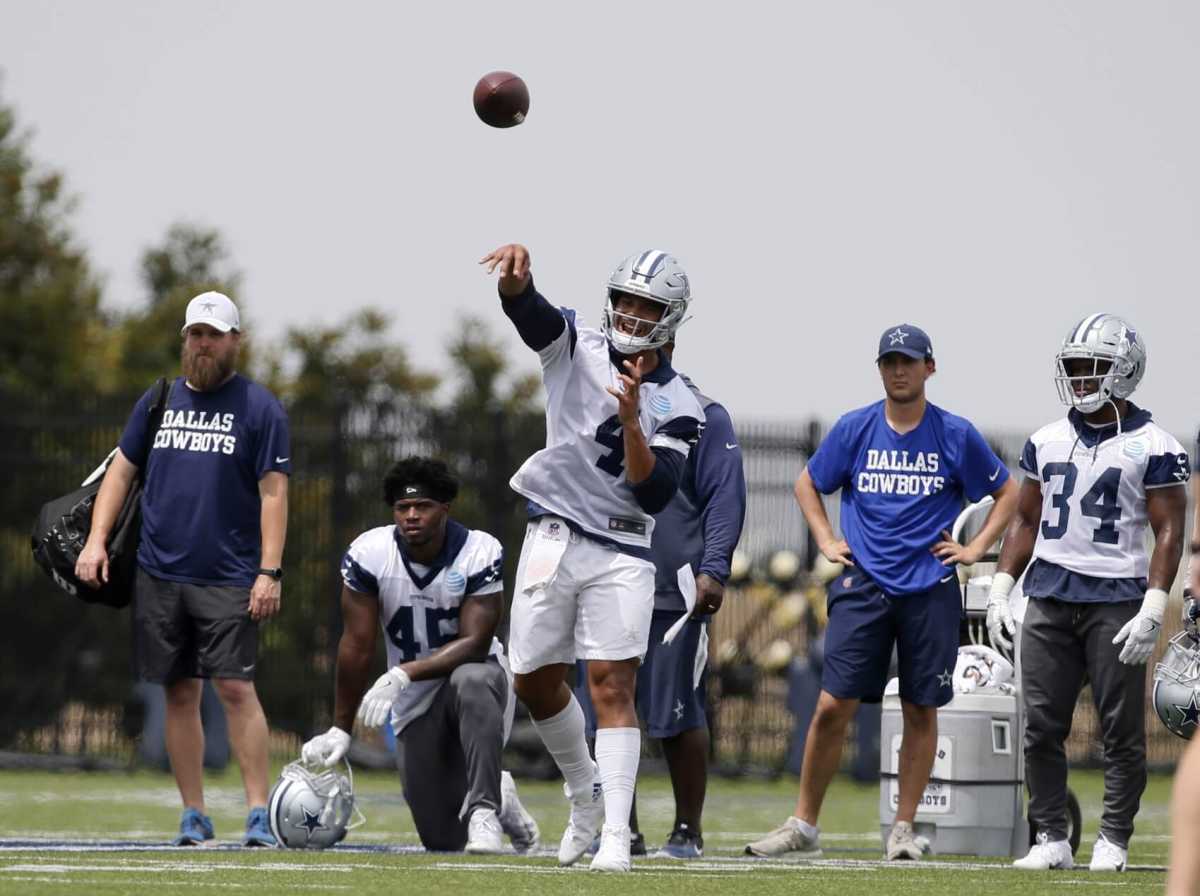While we all get ready to usher in the first full month of summer, we will also be welcoming in a new batch of agonising football-less months. To ease the pain, this new series will be taking a look at the Eagles’ NFC East opponents with true top and bottom line projections: full of arguable and opinion-based forecasts and rife with film study and statistics to back them up. We will begin with position-by-position analysis in an attempt to help you make your own educated decisions on your “buddy’s” favourite team. Beginning today with perhaps our most tantalising opponent, and definitely our most hated, the Dallas Cowboys, I hope to provide you all with true best and worst case scenarios of each team’s offence and defence. Let’s get started.
Quarterback
It is no secret that the prosperity of our star-spangled counterparts to the south is directly tied to the success of their two young darlings Dakota Prescott and Ezekiel Elliott. The latter has proven to be all but a consistent contributor when not suspended, whereas the former has given us a glimpse of both his proverbial floor and ceiling. Most projections have either portrayed 2018-2019 Dak as the world-beater we saw flashes of in his rookie season, or the lackluster game-manager he reverted to sans-Zeke. The reality is probably resting smack dab in the middle, but let’s takes a look at the numbers. In 2017, Dallas was 29th in the league with 493 passing attempts, and 26th in passing yards with 3,141. That averages out to 196.3 yards a game and 6.7 yards per completion (tied for 19th). Dak’s 22 passing touchdowns and 13 interceptions were tied for 18th and 16th respectively. For an offense so obviously dedicated to the run game, none of these numbers are superficially problematic. They finished 23rd in passing yards in 2016 and had the best record in the NFC. However, that team also finished 4th in yards per reception (7.9), and 3rd best in interceptions (6). Accordingly, as you’ll see below, Dak himself suffered a drop-off in his second season.
| Completions | Attempts | Comp. % | Yards | TD | INT | Yards/ATT | QBR | Sacked | |
| 2016 | 311 | 459 | 67.8% | 3667 | 23 | 4 | 8.0 | 104.9 | 25 |
| 2017 | 308 | 490 | 62.9% | 3224 | 22 | 13 | 6.8 | 86.6 | 32 |
Immediately, what jumps off the page is the rise in interceptions. Most would argue, as I would agree, that while this may be indicative of a sophomore slump, it is more likely due to Elliott’s absence. During the running back’s suspension from weeks 10-15 Dak threw for a paltry 5 touchdowns to 7 interceptions, meaning Prescott threw more than half of his interceptions in Zeke’s six games off. However, the drop in yards per attempt would suggest not only a drop in confidence, but a decline in efficiency. Game-manager or not, Dak’s skill set is heavily dependent on his ability to keep the ball secure, while making smart, effective decisions with the plays he is given. The statistics themselves do not indicate such an unravelling as the Cowboys’ record would suggest, nonetheless, film shows a more timid, frantic Dak in year 2.
Highlights from Prescott’s rookie season, while accounting for the occasional overthrow or missed read, show a decisive, calm QB able to glide in the pocket and make plays with his feet when needed. During the beginning of the season, the Cowboys offense functioned notably better when Dak was able to make use of short passes over the middle, check downs to Zeke, and screens to his wide receivers. Make note of this ladies and gents, we’ll come back to it. I, myself found it hard not to notice the zip on Dak’s passes over the middle and despite his early inaccuracy on passes thrown deep and to the outside, he vastly improved towards the latter half of the season.
Jason Garrett smartly included multiple read-options and designed QB runs to get his young gunslinger moving and creating early on in games. Hitting his stride midway through the season, the league was introduced to a technically sound, mobile quarterback that was able to pick apart a defence with the help of a commanding run game. Dak was efficient, rarely made mistakes, was able to create outside of the pocket, and was able to march his offence down the field dinking-and-dunking until someone flies open deep downfield. In both 2016 and 2017 Prescott was among the top 5 most accurate deep ball passers according to Pro Football Focus, despite being in the lower half of the league in the deep-ball attempts column. This is not to understate or undersell the value of the run game. In fact, Prescott had the highest passer rating on play action in 2016. The concern that does become evident in his rookie film is that Prescott is prone to seemingly uncharacteristic lapses in judgement.
This was the first interception of his career in Week 6 of the 2016 season against the Packers.
Two of his four rookie-season interceptions were terribly thrown balls and worse decisions. The third was swatted out of his hand and the fourth was caused by Dez Bryant slipping at the top of his route – hardly Dak’s fault. On most of his poor throws, the opposing defences were able to get pressure through the middle of the line. While Dak’s mobility is evident when rolling, he is hit-and-miss when it comes to stepping up into the pocket. This may have been one of the reasons the Cowboys were unable to beat the Giants in 2016, who were manned by two absolute forces in the middle: Damon Harrison and Johnathan Hankins. It can also be said that, at times, Prescott fails to feel pressure from his blindside. Nevertheless, these mistakes were understandably chalked up to be first year growing pains, as, after all, there were so few of them.
https://youtu.be/Xs1e94Uahjc?t=3m42s
You’ll see Dak throw an interception after facing pressure up the middle.
https://youtube.com/watch?v=PydonzPh02w
This brings us to year 2. Week 2 against the Denver Broncos brought out a Dallas Cowboys the NFL world had yet to encounter. They floundered against a fast, disciplined, high-motor defence. The read-option wasn’t fooling the linebackers, Garrett was unable to dial up any well-timed screens, and the running game was non-existent, forcing Dak to throw the ball fifty, yes five-zero, times. In 2017, when the ‘Boys threw the ball more than 31 times a game, Prescott saw his completion percentage fall to 57.1%. He was 65.9% true when he threw the ball 21-30 times a game. While it is common for a quarterback’s accuracy to share an inverse relationship with his attempts, this statistic should not be overlooked. Regardless of the game script, Dallas cannot be dependent on Dak’s ability to throw 30 or more times a game. Below you’ll see Prescott’s stats when he throws more than 35 times in a game. Three games versus Tampa Bay and Green Bay’s horrendous pass defence skew the data. A notable exception can be made for the game against Baltimore, in which Dak was simply excellent. Still there are some games with an effort you like; some you don’t. And so the polarity continues.
| Game | Attempts | Completion Percentage | Yards | TD:INT |
| 2016 Week 1 vs NYG (L) | 45 | 55.6% | 227 | 0:0 |
| 2016 Week 8 vs PHI (W) | 39 | 48.7% | 287 | 2:1 |
| 2016 Week 11 vs BAL (W) | 36 | 75.0% | 301 | 3:0 |
| 2016 Week 14 @ NYG (L) | 37 | 46.0% | 165 | 1:2 |
| 2016 Week 15 vs TB (W) | 36 | 88.9% | 279 | 0:0 |
| 2016 Divisional vs GB (L) | 38 | 63.2% | 302 | 3:1 |
| 2017 Week 1 vs NYG (W) | 39 | 61.5% | 268 | 1:0 |
| 2017 Week 2 @ DEN (L) | 50 | 60.0% | 238 | 2:2 |
| 2017 Week 4 vs LAR (L) | 36 | 55.6% | 252 | 3:1 |
| 2017 Week 7 vs GB (L) | 36 | 69.4% | 251 | 3:1 |
Following the Denver game, the young QB was able to find his feet again against a weak Arizona team. The week 4 matchup versus the LA Rams figured to be a tough one for Big D due to their aforementioned struggles against pressure up the middle, and the presence of the behemoth known as Aaron Donald. Dak was successfully able to mitigate the pressure by finding Elliott on check downs, two of which went for significant gains and one for a touchdown. Throughout the first half of the season Prescott was able to consistently find open receivers on quick 10-12 yard reads regardless of the pressure he faced. Then, with Elliott’s suspension in week 10, everything came screeching to a halt.
Against Atlanta, Dak was put on his behind eight times while clearly missing his backfield partner on check-down throws. While Zeke isn’t a huge threat in the passing game, he is a reliable safety valve in the flats and can often make something out of nothing. Under fire all game long, Prescott failed to feel pressure from his blind side on multiple occasions: a theme that continued into the Philly game. In week 12 versus the Chargers, we saw a breaking point. Dak put his head down when forced outside the pocket and reverted back to his athleticism; attempting to make plays with his feet instead of his arm. In the final stretch of the season, Prescott had four games of zero touchdowns and multiple interceptions: vs. PHI; vs. LAC; @ OAK; and vs. SEA.
This is what you’d like to see consistently from Dak: keeping his eyes downfield, looking at his options and using the pump-fake to open up space for the run.
On this interception he panics with pressure in his face, throws a ball behind his receiver.
The absence of Elliott in the lineup cannot be overstated, but as teams continue to stack the box against the ‘Boys, the football world is anxious to find out which Dak Prescott will emerge. With a depleted and inexperienced receiving corps, we will see if the young quarterback be able to create for himself like he so often proved capable of in his rookie season, or if the lapses in judgement increase facing growing pressure to succeed in Texas. Without a true number one receiver, Dak will be forced to read the defence and go through his progressions. He had little trouble when asked to do it in college, but the NFL is a different monster. Despite Dez Bryant’s average production over the last two seasons, he has always been a great contested-catch receiver and inspires all-or-nothing bombs downfield. It’ll be interesting to see how the young QB fairs without a teammate to play Jackpot with.
Best Case: Dak looks like himself in 2016 throwing for nearly 4,000 yards, 30 TDs and 8 INTs adding a half dozen scores on the ground. He’s able to cash in on his deep balls, and begins to trust his ensemble of deep threats added in the off season. Most importantly, he keeps the offence rolling, keeping the ball secure and forcing opposing offences to play from behind, where the Cowboys are at their deadliest. Jason Garrett reintroduces a strong screen game and the ‘Boys are able to take advantage of opportunities over the middle of the field. Dak proves he is able to consistently read coverages and work through his progressions.
Worst Case: Despite getting Zeke back, Prescott can’t make the leap expected of him in year three. An unproven receiving corps does nothing to help the confidence of the young QB, and we see him begin to rely on his own talents to make plays happen. While Dallas fans are happy to see him shoulder the burden, a young passer prone to stupid mistakes should not be consistently left to his own devices. He is unable to read through his progressions and starts taking unwarranted deep shots to unproven receivers. Touchdowns go up, but so do interceptions. Otherwise, his stat line is similar what we saw in 2017, and the Cowboys offence becomes essentially one dimensional.
Mandatory Credit: Tim Heitman-USA TODAY Sports




























